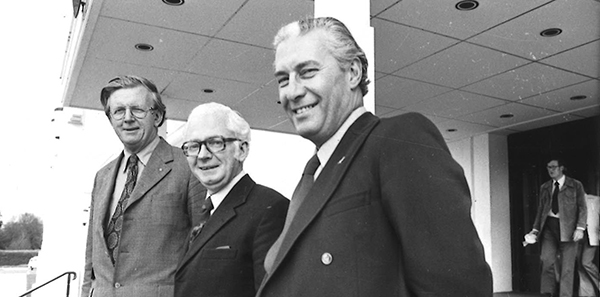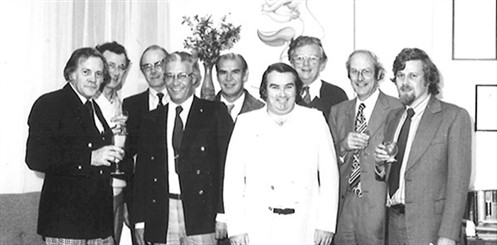1:30min

1975: Australian Optometrical Association President Arthur Ley (R) and Vice President Brian Layland (L) were in the House of Representatives when the bill was returned to the House and accepted. They are pictured leaving the Chamber with MP Len Reynolds.
_____________________________

By Helen Carter
Journalist
Achieving Medicare rebates for optometry consultations is Optometry Australia’s most significant achievement in its 100-year history.
Optometry Australia lobbied for nearly 25 years to have optometry included in the national health scheme and in 1975, when consultations become eligible for government subsidy under Medibank there were four items for optometry in the Medicare Benefits Schedule (MBS).
Sustained lobbying for rebates to be retained and expanded, has seen that grow to 32 optometric MBS items plus four items supporting patients to access tele-ophthalmology, over the past four decades.
Optometry Australia’s National CEO Lyn Brodie said: ‘There would be many optometrists out there who weren’t even born when we successfully lobbied to get optometry items in Medicare 43 years ago and likewise, in 1993, when we launched our campaign against the Keating Government which wanted to remove optometry from the schedule.
‘And today, we continue these efforts to ensure that the value of optometry is recognised in Canberra, and that the community can continue to receive rebates to ensure they can maintain good vision.
‘We have seen so much change in the last 100 years, but I don’t think the sector has ever experienced such rapid change as it has in recent years.
‘Change will not stop or slow down which is why we are working to prepare our members for a future that will likely look very different from today.
‘This is what our Optometry 2040 project is about – putting the foundations in place now for the preferred plausible ‘futures’ that our profession has identified as the future it seeks.’
Other milestones
There have been many other milestones during the organisation’s centenary of serving optometrists and the eye health needs of the Australian public. Other major highlights, resulting from many years of lobbying by Optometry Australia, include removal of the Medicare fee cap, enabling optometrists to set their own fees from 1 January, 2015, and therapeutics legislation and endorsement.
Our important advocacy continues and Optometry Australia has just submitted recommendations to the MBS review on amending the Optometrical Schedule of Services to best meet the eye health needs of the population. Discussions on evolving scope of practice are also underway.
Inclusion in Medicare
Optometry was included in Medicare, then called Medibank, when an Act to amend the Health Insurance Act 1973 was passed by the Senate of the Commonwealth Parliament on 10 June 1975.
The organisation’s then Executive Director Dr Damien Smith, said at the time: ‘Dr Jim Cairns, the Deputy Prime Minister, announced at an international optometry conference in Melbourne in May 1974 that optometry was to be included in Medibank, and said the government had “no reservations” or words to that effect about the qualifications of optometrists.’
In October 1975 at the association’s annual general meeting in Adelaide, Australian Optometrical Association National President, Arthur Ley said: ‘It is with utmost satisfaction that I report that our main objective for nearly one quarter of a century, inclusion into the national health insurance scheme in Australia, has been achieved.’

On 26 September 1975, a dinner to celebrate optometry’s entry into Medibank, now Medicare, was attended by the Australian Optometrical Association National Executive Council (L-R) Lloyd Hewett, William Ure, Charles Wright, National President Arthur Ley, Ronald Fieldhouse, Brian Carlton Smith, Brian Layland, Bruce Besley and Executive Director Damien Smith.
Patients indebted to MP Len Reynolds
Optometry Australia’s newspaper/journal of the time, The Australian Journal of Optometry, reported on the momentous decision and recorded the vital part played by politician, teacher and education lecturer, Len Reynolds.
It said: ‘The successful passage of the Health Insurance Bill, 1975 through the Australian Parliament was the culmination of 12 years of active support for the measure by the House of Representatives member for the NSW electorate of Barton, Mr Len Reynolds.
‘Examination of Hansard over that period reveals that it has been Mr Reynolds who has consistently raised the case in favour of National Health Benefits for the patients of Australia’s optometrists.
‘Initially, Len Reynolds’ efforts were directed towards a removal of discrimination against the patients of optometrists which resulted from the old National Health Act. When the Labor Government was elected in December 1972 his long-recognised role as spokesman for the patients of optometrists and for the optometric profession became a more rewarding role as the Labor Government quickly set about removing the anomalies in the National Health Scheme.
‘At the time of the Double Dissolution election in May 1974 the Government announced its intention to introduce benefits for optometrists’ consultations. Since that time Mr Reynolds has actively assisted negotiations by members of the Australian Optometrical Association during their frequent visits to Parliament and has ensured that the view of the Association’s members was presented at vital discussions during the formulation of the scheme.
‘History will record the part played by Len Reynolds in this matter; optometrists and their patients are indebted to him.’
100-year milestones:
- 1918 – Australasian Optometrical Association established
- 1941 – Full-time optometry course commenced in Victoria, which was jointly at the Australian College of Optometry and The University of Melbourne, with Jonathan Nathan as the first registered student.
- 1954 – First optometry course established at University of NSW
- 1970 – Optometrists win the right to make direct referrals to ophthalmologists
- 1975 – Optometrist consultations become eligible for government subsidy under Medibank (now Medicare)
- 1985 – Veterans can attend optometrists without prior medical approval, after association lobbying
- 1986 – ACT optometrists join colleagues in NSW and Victoria in being legally allowed to administer diagnostic drugs, followed in 1987 by Queensland optometrists and 1992 by WA optometrists
- 1991 – In the first therapeutic drug move, AOA pushes for legislative change to allow optometrists to use topical ocular drugs to treat anterior infections and other minor disorders; Medicare to pay same benefit for spectacle prescription consultations whether by optometrist or ophthalmologist
- 1993 – Australian Optometrical Association successfully lobbies to have Keating government decision to remove the Medicare rebate for optometric consultations overturned; AOA develops entry level competency standards
- 1994 – Medicare introduces the short consultation item 10906; WA wins right to use mydriatic and cycloplegic drugs in children under eight; SA optometrists permitted to use diagnostic drugs
- 1996 – Victoria becomes first state to legislate to let optometrists use and prescribe S4 drugs
- 1998 – In most significant change to optometry since Medicare, Victoria approves list of 41 therapeutic drugs for use by optometrists; Federal government recognises optometrists’ role in reducing diabetes toll by including optometry in national diabetic retinopathy advisory group.
- 2000 – Therapeutic drugs list includes glaucoma medications; Tasmanian law enables practitioners to use and prescribe therapeutics
- 2002 – After 17-year fight NSW Optometrists Bill passes granting therapeutics access
- 2004 – NT practitioners gain access to ocular therapeutics
- 2006 – Increase in MBS scheduled fee from 85 to 100 per cent for DVA consults
- 2007 – The first optometrists are granted authority to prescribe therapeutic drugs in NSW; ACT legislation gives optometrist right to prescribe therapeutics; Legislation includes optometric prescriptions in the PBS
- 2008 – Prescriptions for medications written by optometrists become eligible for government subsidy under the PBS
- 2009 – Topical glaucoma medications prescribed by optometrists included in PBS; First SA optometrists authorised to prescribe ocular therapeutics
- 2010 – OAA plays key role in supporting profession’s move to a national registration system; WA optometrists get access to prescribe therapeutic medications
- 2011 – Doctor of Optometry course launched at University of Melbourne
- 2015 – ‘Cap’ on fees optometrists could charge under Medicare removed after Optometry Australia lobbying
- 2018 – OA recommendations submitted to MBS Review on amending the Optometrical Schedule of Services to best meet the eye health needs of the population
A correction was made to this article on 10 September, 2018.
_____________________________
Tagged as: Milestones